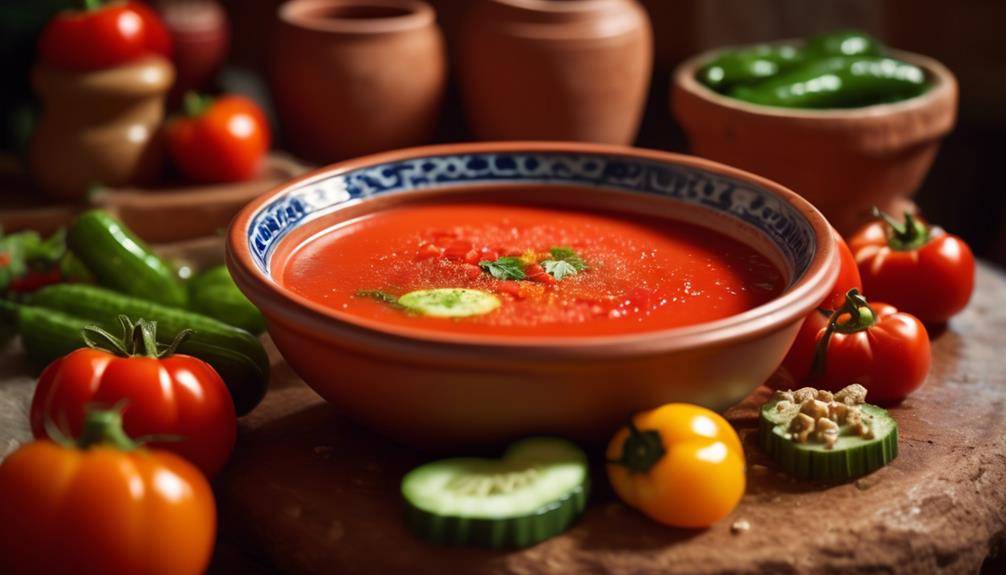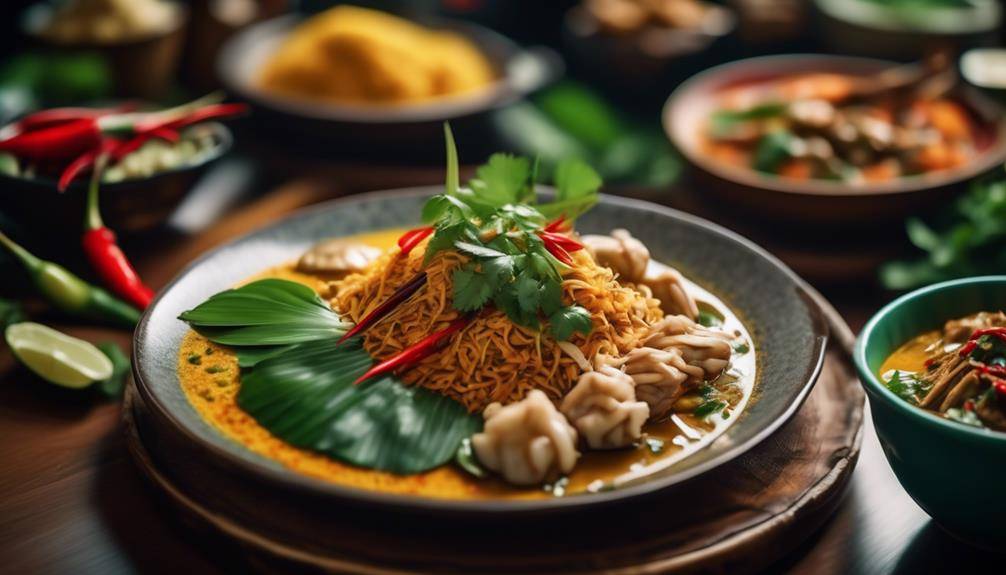Amazing Traditional Spanish Soups And Stews

Traditional Spanish Soups And Stews; Did you know that Spain has a rich culinary tradition of soups and stews? From the refreshing gazpacho to the hearty fabada asturiana, there is something for everyone to enjoy. These traditional Spanish soups and stews not only showcase the country’s diverse regional flavors but also tell stories of history and culture. So, if you’re curious to learn more about the tantalizing flavors and unique ingredients that make up these iconic dishes, join us as we embark on a culinary journey through the vibrant world of traditional Spanish soups and stews. Get ready to savor the warmth and depth of flavors that will transport you to the heart of Spain.
Gazpacho: A Refreshing Cold Tomato Soup
Gazpacho is a delightfully refreshing and vibrant cold tomato soup that will awaken your taste buds on a hot summer day. This traditional Spanish dish is not only delicious but also packed with nutrients. The beauty of gazpacho lies in its simplicity and versatility, as there are various ways to prepare and enjoy it.
When it comes to preparing gazpacho, the key is to use fresh, ripe tomatoes. Start by peeling and deseeding the tomatoes, as the skin and seeds can give the soup a bitter taste. You can blanch the tomatoes in boiling water for a few seconds to easily remove the skin. Next, chop the tomatoes and place them in a blender along with cucumber, bell peppers, garlic, and onions. Add a splash of olive oil, vinegar, salt, and pepper to taste. Blend everything until smooth and adjust the seasoning if needed. For a smoother consistency, you can strain the soup before serving.
While the classic gazpacho recipe calls for these basic ingredients, there are countless variations you can try. For instance, you can add some heat with a dash of Tabasco sauce or chili powder. You can also experiment with different vegetables like avocados, watermelon, or even strawberries. Additionally, you can garnish your gazpacho with fresh herbs like basil or cilantro, or top it off with diced cucumbers, croutons, or a drizzle of balsamic glaze.
Gazpacho is not only a refreshing soup but also a great way to make use of seasonal produce. Whether you stick to the traditional recipe or get creative with your own variations, one thing is for sure – gazpacho is the perfect summer soup that will leave you feeling refreshed and satisfied. So, go ahead and give it a try – your taste buds will thank you!
Fabada Asturiana: A Hearty Bean Stew
Now let’s talk about Fabada Asturiana, a hearty bean stew that originates from the Asturias region of Spain. This traditional dish is made with white beans, typically faba beans, and a variety of meats such as chorizo, morcilla (blood sausage), and pork. The stew is slow-cooked to allow the flavors to meld together, resulting in a rich and comforting dish that is perfect for colder weather. To serve, it is traditionally enjoyed with crusty bread and a glass of cider, adding to its rustic charm.
Ingredients and Preparation
To create the hearty and flavorful Fabada Asturiana, start by gathering the essential ingredients and preparing them with care and attention. This traditional bean stew from the Asturias region of Spain is known for its rich and smoky flavors. Here are the key ingredients and steps to make this delicious dish:
- Dried white beans: The star of the dish, these beans are soaked overnight to soften and then cooked slowly until tender.
- Pork products: Fabada Asturiana traditionally includes chorizo, morcilla (blood sausage), and pancetta. These meats add depth and richness to the stew.
- Saffron: This expensive spice adds a touch of complexity and a vibrant yellow color to the dish.
- Smoked paprika: A key ingredient in many Spanish dishes, the smoky flavors of paprika give Fabada Asturiana its distinctive taste.
To prepare the stew, start by sautéing the meats until they release their flavors. Then, add the beans, saffron, and paprika, along with water or stock, and let it simmer slowly until the flavors meld together. The result is a hearty and satisfying stew that showcases the regional influences and cooking techniques of the Asturias region.
Serving Suggestions
Looking to elevate your Fabada Asturiana experience? Here are some presentation tips and pairing suggestions to make your meal even more enjoyable. When it comes to presenting Fabada Asturiana, simplicity is key. Serve the stew in a deep bowl or clay pot to showcase its rich and hearty nature. Sprinkle some freshly chopped parsley or a drizzle of olive oil on top for added freshness and visual appeal.
Pairing this dish with a glass of bold red wine, such as a Rioja or Tempranillo, will complement the flavors of the stew perfectly. If you prefer beer, opt for a rich and malty brew like a dark ale or a stout. Additionally, serving crusty bread or toasted baguette slices on the side will provide a satisfying crunch and help soak up the flavorful broth. Enjoy!
Caldo Gallego: A Traditional Galician Soup
Let’s talk about the key points when it comes to Caldo Gallego, a traditional Galician soup. First, the ingredients and preparation of this soup are quite simple, consisting of white beans, potatoes, greens, and meat, typically ham or chorizo. Next, there are regional variations of Caldo Gallego, with some areas adding different types of meat or vegetables to enhance the flavor. Finally, when serving and garnishing this soup, it is common to drizzle it with olive oil and sprinkle it with paprika, giving it a finishing touch that complements the richness of the soup.
Ingredients and Preparation
When preparing Caldo Gallego, a traditional Galician soup, begin by gathering the essential ingredients and following a simple yet flavorful preparation method. This hearty soup reflects the regional influences of Galicia, a coastal region in northwest Spain known for its abundance of fresh seafood and hearty cuisine. The cooking techniques used in Caldo Gallego are designed to bring out the flavors of the ingredients and create a satisfying and comforting dish. To make this soup, you will need:
- White beans: These provide a creamy texture and are a staple in Galician cuisine.
- Potatoes: They add substance to the soup and help thicken the broth.
- Leafy greens: Typically, collard greens or kale are used to add a fresh and earthy flavor.
- Smoked pork: Chorizo or bacon is often added for a smoky and savory taste.
To prepare Caldo Gallego, start by simmering the white beans and smoked pork in water until tender. Then, add the potatoes and greens, cooking until everything is soft and the flavors have melded together. Serve hot and enjoy the comforting flavors of this traditional Galician soup.
Regional Variations
Regional variations add a unique twist to Caldo Gallego, a traditional Galician soup that showcases the diverse culinary influences of the different provinces within Galicia. Each region within Galicia has its own distinct way of preparing this hearty soup, resulting in subtle differences in flavor and texture. For example, in the coastal regions, seafood such as clams or shrimp may be added to the soup, giving it a briny and oceanic taste. Inland regions, on the other hand, often incorporate cured meats like chorizo or ham, adding a smoky and savory element to the dish.
Additionally, cooking techniques vary from region to region, with some preferring a slow simmer to develop deep flavors, while others opt for a quicker cooking time to maintain the freshness of the ingredients. These regional variations truly make Caldo Gallego a reflection of Galicia’s rich culinary heritage.
Serving and Garnishing
To serve and garnish Caldo Gallego, there are a variety of traditional accompaniments that enhance the flavors and add visual appeal to this comforting Galician soup. Here are some serving techniques and garnishing tips to elevate your Caldo Gallego experience:
- Serve the soup hot in individual bowls, making sure to include a generous amount of the delicious broth, vegetables, and meat.
- Accompany the soup with slices of crusty bread, perfect for soaking up the flavorful broth.
- Garnish with a sprinkle of freshly chopped parsley, adding a pop of color and a hint of freshness to the dish.
- For an extra touch, drizzle a small amount of extra virgin olive oil on top, enriching the flavors and adding a silky texture to the soup.
Escudella I Carn D’olla: a Catalan Meat and Vegetable Stew
If you’re looking for a hearty and flavorful stew to warm you up on a chilly day, look no further than Escudella I Carn D’olla, a traditional Catalan dish packed with tender meat and vibrant vegetables. This regional Catalan cuisine is a true representation of traditional meat stew, offering a delicious and satisfying meal that has been enjoyed for generations.
Escudella I Carn D’olla is a rich and comforting stew that brings together a variety of ingredients to create a harmonious and flavorful dish. The main components of this stew are the meats, which typically include beef, pork, and chicken. These meats are simmered slowly to perfection, allowing them to become tender and infused with the flavors of the stew.
In addition to the meats, Escudella I Carn D’olla also incorporates a wide range of vegetables. Potatoes, carrots, leeks, and cabbage are commonly used, adding both texture and flavor to the stew. The vegetables are cooked in the broth created by simmering the meats, allowing them to absorb all the delicious flavors.
One of the unique aspects of Escudella I Carn D’olla is the addition of traditional Catalan meatballs called pilotes. These meatballs are made with a mixture of ground beef, bread crumbs, eggs, and spices. They are then added to the stew, complementing the other meats and vegetables with their rich and savory flavors.
Escudella I Carn D’olla is often served in two parts. First, the broth is enjoyed as a soup, accompanied by noodles or rice. Then, the meats and vegetables are served as the main course, offering a filling and satisfying meal.
Sopa De Marisco: a Seafood Soup From the Mediterranean
Savor the flavors of the Mediterranean with Sopa De Marisco, a delectable seafood soup that showcases the best of the region’s bountiful waters. This traditional Spanish dish has variations and regional differences, but it always features a rich broth infused with the flavors of the sea. Here are some key things to know about this mouthwatering soup:
- Ingredients: Sopa De Marisco typically includes a combination of seafood such as prawns, mussels, clams, and fish, along with vegetables like onions, garlic, and tomatoes. The soup is often seasoned with aromatic herbs and spices like paprika and saffron, which add depth and complexity to the dish.
- Regional Differences: While Sopa De Marisco is enjoyed throughout Spain, different regions put their own spin on the soup. In Catalonia, for example, it may include local ingredients like langoustines, while in Andalusia, it might feature a touch of sherry for added flavor. These regional variations highlight the diverse culinary traditions found across the country.
- Health Benefits: Seafood is the star of Sopa De Marisco, and it brings numerous health benefits to the table. Seafood is an excellent source of lean protein, omega-3 fatty acids, vitamins, and minerals. These nutrients contribute to heart health, brain function, and overall well-being. Plus, the abundance of vegetables in the soup provides even more vitamins and fiber.
- A Taste of the Mediterranean: With its fresh seafood, vibrant flavors, and aromatic spices, Sopa De Marisco offers a true taste of the Mediterranean. It is a dish that celebrates the bounty of the sea and the rich culinary traditions of Spain. So, take a spoonful of this delightful soup, and let the flavors transport you to the sunny shores of the Mediterranean.
Cocido Madrileño: a Meat and Chickpea Stew From Madrid
Indulge in the hearty flavors of Madrid with Cocido Madrileño, a meat and chickpea stew that will warm your soul. This traditional dish showcases the regional influences and cooking techniques of Madrid, making it a favorite among locals and visitors alike.
Cocido Madrileño is a stew that dates back to the 16th century and has been a staple in Madrid’s cuisine ever since. It is a dish that reflects the rich history and diverse culinary traditions of the region. The stew typically consists of various cuts of meat such as beef, pork, and chicken, along with vegetables like carrots, potatoes, and cabbage. The star ingredient, however, is the humble chickpea, which adds a satisfying and creamy texture to the stew.
One of the key aspects that sets Cocido Madrileño apart is the cooking technique. The stew is traditionally prepared in a two-step process. First, the meats and vegetables are simmered together in a flavorful broth until they are tender and infused with all the delicious flavors. Then, the chickpeas are added and cooked until they are soft and creamy. This method allows the flavors to develop and meld together, creating a harmonious and comforting dish.
Cocido Madrileño is often served in multiple courses, starting with the broth accompanied by fideos, a type of thin noodle. This is followed by the meats, vegetables, and chickpeas, which are served separately. This allows for a unique dining experience where each component can be savored individually or combined to create different flavor combinations.
Whether you’re exploring the bustling streets of Madrid or simply craving a hearty and satisfying meal, Cocido Madrileño is a must-try dish that will transport you to the heart of Spain. Its regional influences and cooking techniques make it a true culinary gem that showcases the rich and diverse flavors of Madrid.
Salmorejo: a Creamy Tomato Soup From Andalusia
Salmorejo, originating from the region of Andalusia, is a lusciously creamy tomato soup that captures the essence of Spanish cuisine. This delectable soup is a popular dish in Andalusia, particularly in the cities of Cordoba and Seville. Here are a few things you should know about salmorejo:
- Simple Ingredients, Rich Flavor: Salmorejo is made with just a handful of ingredients, including ripe tomatoes, day-old bread, garlic, olive oil, and sherry vinegar. Despite its simplicity, the combination of these ingredients creates a rich and velvety texture with a burst of fresh tomato flavor.
- Regional Variations: While the basic recipe remains the same, there are slight regional variations in the preparation of salmorejo. For example, in Cordoba, it is common to garnish the soup with chopped hard-boiled eggs and crispy Iberian ham. In Seville, it is served with diced Serrano ham and croutons. These variations add an extra layer of flavor and texture to the dish.
- Serving Suggestions: Salmorejo is typically served chilled, making it a perfect dish for hot summer days. It is often enjoyed as an appetizer or a light lunch, accompanied by a crusty baguette or toasted bread. The soup can also be topped with a drizzle of olive oil for added richness and a sprinkle of fresh herbs, such as parsley or basil, for a pop of color.
- Versatility: While salmorejo is delicious on its own, it can also be used as a base for other dishes. It can be transformed into a refreshing gazpacho by adding some cucumber and bell peppers. Additionally, salmorejo can be used as a sauce or a dip for grilled vegetables, seafood, or even as a dressing for salads.
With its creamy texture, vibrant color, and refreshing taste, salmorejo is a true culinary delight that showcases the flavors of Andalusia. Whether you enjoy it as a starter or a main course, this traditional Spanish soup is sure to leave you craving for more.
Frequently Asked Questions: Traditional Spanish Soups And Stews
How Long Should Gazpacho Be Refrigerated Before Serving?
To serve gazpacho at the perfect temperature, refrigerate it for at least 2 hours. This allows the flavors to meld and the soup to become chilled. Gazpacho variations include adding fruits, vegetables, or even seafood for a unique twist.
What Is the Best Type of Bean to Use in Fabada Asturiana?
The best type of bean to use in fabada asturiana is the faba bean. It is a large white bean that is creamy and tender when cooked. The traditional cooking method for fabada asturiana involves soaking the beans overnight and then simmering them with various meats and seasonings. There are variations of fabada asturiana recipes that include different types of meats and vegetables.
Can Caldo Gallego Be Made With Vegetarian Ingredients?
Yes, caldo gallego can be made with vegetarian ingredients. Instead of chorizo, you can use vegetarian substitutes like tofu or tempeh. There are also variations of gazpacho recipes that use vegetarian ingredients.
What Is the Traditional Meat Used in Escudella I Carn D’olla?
The traditional meat used in escudella i carn d’olla is typically pork, such as pork ribs or shoulder. However, if you’re looking for a vegetarian alternative for this traditional Spanish stew, you can substitute it with tofu or seitan for a similar texture and flavor.
Are There Any Specific Types of Seafood That Should Be Used in Sopa De Marisco?
When making sopa de marisco, it’s important to use specific types of seafood to enhance the flavors. Shrimp, mussels, clams, and fish are commonly used. If you’re vegetarian, you can substitute the seafood with vegetables or tofu for a delicious alternative in caldo gallego.
Conclusion
In conclusion, traditional Spanish soups and stews offer a delightful and diverse range of flavors that are sure to satisfy any palate. From the refreshing gazpacho to the hearty fabada asturiana, these dishes showcase the rich culinary heritage of Spain. Whether you’re looking for a light and refreshing soup or a filling and comforting stew, the traditional Spanish recipes mentioned in this article are sure to transport you to the vibrant streets of Spain with every spoonful.








